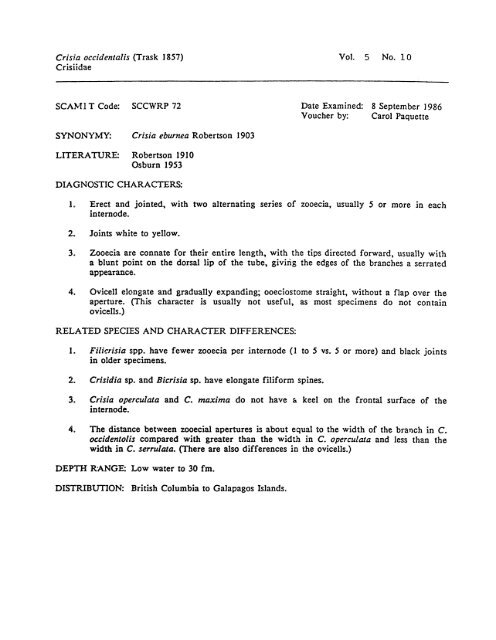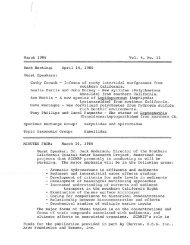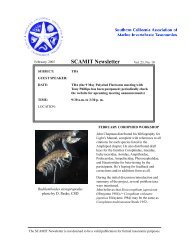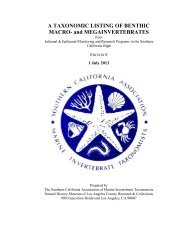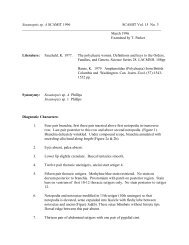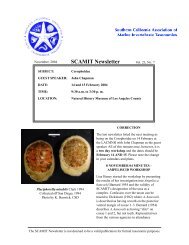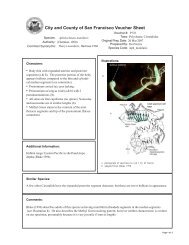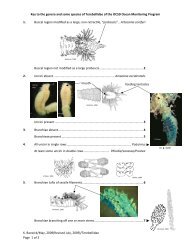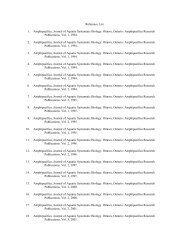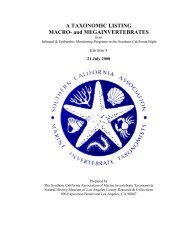Crisia occidentalis.pdf - scamit
Crisia occidentalis.pdf - scamit
Crisia occidentalis.pdf - scamit
Create successful ePaper yourself
Turn your PDF publications into a flip-book with our unique Google optimized e-Paper software.
Crista <strong>occidentalis</strong> (Trask 1857)<br />
Crisiidae<br />
Vol 5 No. 10<br />
SCAMIT Code: SCCWRP 72 Date Examined: 8 September 1986<br />
Voucher by: Carol Paquette<br />
SYNONYMY: <strong>Crisia</strong> eburnea Robertson 1903<br />
LITERATURE: Robertson 1910<br />
Osburn 1953<br />
DIAGNOSTIC CHARACTERS:<br />
1. Erect and jointed, with two alternating series of zooecia, usually 5 or more in each<br />
internode.<br />
2. Joints white to yellow.<br />
3. Zooecia are connate for their entire length, with the tips directed forward, usually with<br />
a blunt point on the dorsal lip of the tube, giving the edges of the branches a serrated<br />
appearance.<br />
4. Ovicell elongate and gradually expanding; ooeciostome straight, without a flap over the<br />
aperture- (This character is usually not useful, as most specimens do not contain<br />
ovicells.)<br />
RELATED SPECIES AND CHARACTER DIFFERENCES:<br />
1. Filicrisia spp. have fewer zooecia per internode (1 to 5 vs. 5 or more) and black joints<br />
in older specimens.<br />
2. Crisidia sp. and Bicrisia sp. have elongate filiform spines.<br />
3. <strong>Crisia</strong> operculata and C. maxima do not have a keel on the frontal surface of the<br />
internode.<br />
4. The distance between zooecial apertures is about equal to the width of the branch in C.<br />
occidentolis compared with greater than the width in C. operculata and less than the<br />
width in C. serrulata* (There are also differences in the ovicells.)<br />
DEPTH RANGE: Low water to 30 fm.<br />
DISTRIBUTION: British Columbia to Galapagos Islands.
Crista <strong>occidentalis</strong> (Trask 1857) Vol. 5 No. 10<br />
Crisiidae<br />
pc. int.<br />
from Robertson 1910<br />
W.<br />
it<br />
Fig. II. Crinia oecidcntulU Trask. Hnbit sketch. X 1.<br />
Fig. 12. C. occitlcututi*. A portion of a colony allowing branching,<br />
|M»cially of the oa«ciaI interncule. In this, the ocrciuiti (oe.) is the fifth<br />
ember of the intcrnode; the first branch (br. J) arising in a basis rami<br />
'm. r.), not wedged in, but attached to the side of the third zoo?ctum; the<br />
•cond branch (br. 2) arising on the side of the sixth zocccium, the<br />
Milium which pairs with the ourciuni; the third branch (br. J) arising<br />
i the ninth zocrcium just aliove the summit of the oviccll. The distal<br />
»rtion of the oo?ciaI internodc carrying the zoarial growth upward. X 36.<br />
from Osburn 1953<br />
Fig. 3. Crista <strong>occidentalis</strong> Trask, showing mode of branching and<br />
normal form of oviccll.<br />
Fig. 4. The same, distorted oviccll due to curved internodc.<br />
Fig. 5. The same, pointed tip of terminal internodc, often proem.


